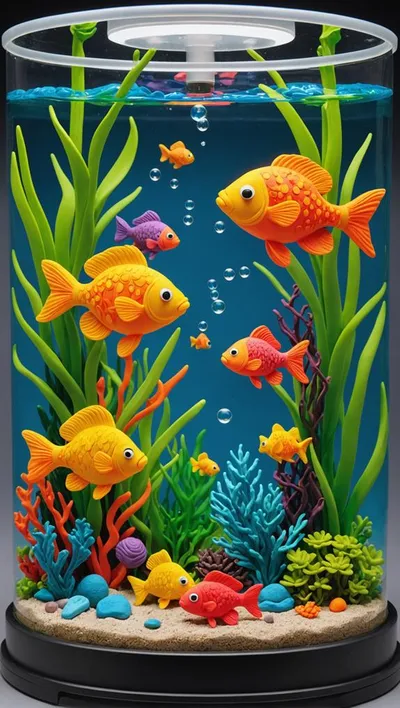When spring rolls around, it's time to boost those breeding efforts! Start by warming the water to 78-82°F, keeping it stable to keep your fish stress-free. Select vibrant, energetic fish ideally around a year old, and give them a protein-packed diet to get them in the mood. Set up a cozy spawning tank with hiding spots and safe egg-laying surfaces. Don't forget regular water changes to keep things clean and balanced! Watch for exciting courtship behaviors, like colorful displays and nesting. Stick with us, and you'll uncover even more tips to help your fish thrive!
Contents
Optimal Breeding Conditions
Creating optimal breeding conditions for fish is essential to ensure successful reproduction. To kick things off, raise the water temperature to around 78-82°F. This warmth mimics the spring season, triggering those spawning behaviors we all love to see.
Maintaining stable water parameters is also crucial during this time, as fluctuations can cause stress and impact breeding success. Next, don't forget about water changes; they're like a refreshing rain shower for your fish, helping to encourage breeding. A slightly acidic to neutral pH, ideally between 6 and 7, is also crucial for egg fertilization.
Now, let's talk about food. Providing high-protein foods during the conditioning phase is key. It strengthens your breeding pairs and boosts their chances of success. Think of it as a gourmet diet—who wouldn't want that?
Setting up a spawning tank is vital too. Make sure it has plenty of hiding spots and suitable substrates for your fish to lay their eggs. This not only encourages egg laying but also protects those little fry from being snacked on by their parents.
It's a tough world out there! So, by creating these optimal breeding conditions, you're setting the stage for a thriving aquatic family. Your fish will thank you!
Essential Water Quality Checks
How can you ensure your fish thrive during breeding? Paying close attention to water quality is key! Start by testing for ammonia, nitrite, and nitrate levels. You want ammonia and nitrite to sit at zero—like a perfect score—while keeping nitrates below 20 ppm. This balance is crucial for breeding success, as maintaining consistent testing fosters a balanced water quality that's vital for fish health.
Next, let's talk about pH levels. Most freshwater fish prefer a stable pH between 6 and 7. If it needs adjusting, don't hesitate to use those handy commercial pH products.
Also, monitor water hardness, aiming for a range of 3 to 10 dGH. Different fish have different preferences, and this can affect their willingness to breed.
Don't forget to conduct regular water changes, about 10 to 25% each week. This keeps toxins at bay and makes your fish feel comfortable.
And always use a water conditioner to remove chlorine and heavy metals during changes. Remember, a happy fish is a breeding fish!
Selecting Healthy Breeding Pairs

When you're selecting healthy breeding pairs, it's crucial to start with vibrant, lively fish that catch your eye.
You'll want to look for males with flashy colors and slimmer bodies, while females should be fuller and rounded—just like picking the best fruit at the market!
Assessing Fish Health
Selecting healthy breeding pairs is crucial for successful fish reproduction, as vibrant colors and energetic behavior indicate overall vigor. When you're assessing fish health, look for adult fish that are lively and well-proportioned.
Ideally, you want to choose vibrant-colored males and females that show strong bodies and dynamic movement. Sick, injured, or deformed fish? Forget it! They can negatively impact the health of future generations.
You should also keep an eye out for the physical traits of the sexes. Males often flaunt brighter colors and slimmer bodies, while females usually have rounder abdomens. This helps you pick the right breeding pairs! Aim for fish that are at least a year old, since older fish are generally more successful at breeding.
Timing's everything, too. Acquiring your breeding pairs in late winter or early spring aligns with their natural breeding cycles, increasing the chances of successful reproduction.
Identifying Sex Characteristics
Understanding the nuances of sex characteristics in fish is essential for successful breeding. Identifying their sex can make all the difference when you're selecting healthy breeding pairs.
Male fish often display bright colors and unique fin shapes that shout, "I'm ready to breed!" During the breeding season, look for males with breeding stars or tubercles on their fins, especially in species like cichlids.
On the other hand, females typically have rounder, fuller bodies when they're eggs-loaded, which makes them easier to spot. Observing behaviors can also help you determine sex; male fish frequently show territorial behaviors, acting aggressive to attract those lovely females.
If you're still unsure, consider keeping a group of juvenile fish. Sometimes, sex differences aren't fully apparent until they mature, so patience is key here.
Choosing Compatible Species
After identifying the sex characteristics of your fish, the next step is choosing compatible species to create healthy breeding pairs.
It's crucial to select healthy specimens of the same species, as crossbreeding can lead to weak or sterile offspring. So, keep your eyes peeled for vibrant fish that show no signs of disease or deformities.
Males usually flaunt brighter colors and slimmer bodies, making them easier to spot. Aim for a male-to-female ratio of 1:2 for the best breeding success.
This setup encourages natural courtship behaviors and keeps the males from feeling overwhelmed.
You'll want to focus on mature fish that are at least six months old. Younger fish simply aren't ready for the big breeding game yet.
Ensuring your fish are at sexual maturity is a game-changer for fishing breeding.
Conditioning Fish for Breeding
Conditioning fish for breeding is a crucial step that can significantly increase your chances of successful spawning. To get your fish in the mood, start by feeding them a high-protein diet. Think brine shrimp, daphnia, and white worms—delicious treats that will keep them happy and healthy! Aim for at least two weeks of this special diet.
During this time, ensure that your tank is properly cycled to foster a healthy environment, as a stable nitrogen cycle is vital for the well-being of your fish and increases their chances of successful breeding a stable nitrogen cycle.
Next, you'll want to keep the water temperatures cozy, ideally between 78-82°F. This simulates those lovely spring conditions that trigger breeding behaviors.
Don't forget to change the water regularly and monitor the pH levels, which should be around 6-7 for many freshwater species.
Creating a separate conditioning tank for your breeding pairs is also a smart move. This little sanctuary minimizes stress and encourages them to show off their vibrant mating colors.
Keep a close eye on your fish, too. You'll notice increased activity levels as they get more excited about spawning.
With these tips, you're well on your way to creating a breeding-friendly environment. Get ready for some fishy romance!
Setting Up the Spawning Tank

Setting up the spawning tank is crucial for your fish's breeding success, so let's make it cozy!
You'll need at least a 5-10 gallon tank, packed with soft plants and surfaces to encourage egg-laying.
Don't forget to keep the water clean and at a steady temperature, because happy fish are more likely to become proud parents!
Tank Size Considerations
When creating a spawning tank, it's crucial to choose an appropriate size that supports both the breeding pairs and the developing fry. Ideally, your breeding tank should hold about 5-10 gallons, which allows for proper water circulation and gives the fry a cozy space to hide.
Fish love to have their own little nooks, so including plants or stones creates those perfect secluded spots where they can feel safe during the spawning season.
If you're diving into Koi breeding, you'll need a larger setup—think of a tank or pond that's at least 4 x 4 x 2 feet, holding around 200 gallons. This size is essential for a healthy environment where your fish can thrive.
Don't forget about water quality. Keeping it stable is key to reducing stress for your breeding pairs and maximizing your chances of success.
A low-power filter can help maintain gentle water flow without disrupting their little romance. As fry grow larger, they'll appreciate the space to swim freely, making it all the more rewarding for you as their caretaker. Happy breeding!
Environmental Enhancements Needed
Creating a suitable environment for your breeding fish goes beyond just tank size; it involves enhancing the spawning tank to mimic their natural habitat. You want your fish to feel at home, encouraging them to show off their best breeding behaviors.
Start with a minimum of 5-10 gallons for your breeding tank, allowing ample space for your fish to thrive.
To really set the stage, consider these emotional enhancements:
- Fine gravel or spawning mops for natural egg-laying sites
- Gentle water circulation to keep your fish calm
- Water temperature between 78-82°F to spark those romantic instincts
- Hiding spots from decorations or plants to help adult fish feel secure
- Safe spaces for fry to boost their survival chances
With these features in place, you'll create an inviting atmosphere for your adult fish, paving the way for successful spawning.
Don't forget that optimal water quality is crucial for both eggs and fry, so keep that in mind as you set up. Happy breeding, and may your fish family grow!
Water Quality Maintenance
Maintaining water quality is crucial for the health and success of your breeding fish. Start by setting up a spawning tank that's between 5-10 gallons, equipped with proper filtration.
Clean water is essential for breeding success, so make sure to keep the environment stable. You'll want to monitor the water temperature, aiming for that sweet spot of 78-82°F, which mimics their natural spawning conditions.
Regularly test your water for ammonia, nitrate, and pH levels. A slightly acidic pH of 6-7 is ideal for reproduction, creating a cozy atmosphere for your fish.
Don't forget to incorporate live plants or spawning substrates; they provide hiding spots for eggs and fry, helping to keep them safe from potential predators.
Perform partial water changes of 25-50% regularly, using water from the same source to maintain consistency. This simple step can work wonders for your overall water quality, ensuring your fish feel right at home.
Fry Care and Nutrition
Caring for newly-hatched fry is crucial for their survival and growth, especially during the first 24 hours when they rely on their yolk sac for nourishment. During this critical period, it's essential to keep a close eye on them.
After their yolk sac is absorbed, you can introduce finely crushed flakes or powdered foods along with infusoria. This ensures your fry receive the right nutrition as they grow.
Feed your fry at least six times daily to prevent starvation. Their tiny stomachs need frequent, small meals to thrive. Essential early foods include hardboiled egg yolk paste and live foods like baby brine shrimp, which are protein-packed and promote healthy growth.
Here are some tips to keep in mind:
- Keep water quality pristine with regular changes
- Use water from the same source to avoid shock
- Monitor fry closely for signs of distress
- Offer a variety of foods to encourage healthy eating
- Create a nurturing environment that fosters growth
Monitoring Fish Behavior

Monitoring fish behavior closely during the breeding season can reveal vital signs of their readiness to mate. As spring rolls in, you'll notice male fish showcasing their vibrant colors and ramping up their activity. It's like they're putting on their Sunday best to attract the ladies!
Keep an eye out for frequent chasing, especially between males and females—this is a classic courtship move.
You'll also want to watch for spawning behaviors, like nest building or hovering around ideal breeding spots. These actions suggest that your fish are getting ready to lay eggs.
Male fish can be quite the show-offs during this time; flaring their fins and displaying territorial behavior is all part of their strategy to catch the attention of potential mates.
Don't forget to monitor their appetite, either. Some fish might eat less or even stop eating altogether while they focus on the important business of breeding. It's their way of saying, "I'm too busy to munch!"
Common Breeding Challenges
Encountering common breeding challenges can be frustrating for any fish enthusiast. You want the best for your fish, but sometimes, things don't go as planned. Here are a few hurdles you might face during fish breeding:
- Limited hiding spots can lead to adult fish snacking on fertilized eggs.
- Males can get overly aggressive, causing injuries to their partners.
- Fry need specialized foods; without them, they might face starvation.
- Predators lurking in the tank can threaten your newborn fish.
- Environmental instability, like temperature swings or poor water quality, can derail your hard work.
To tackle these challenges, ensure you provide ample hiding spots for eggs and fry.
Monitor your fish's behavior closely to mitigate aggression, and keep an eye on water conditions.
Don't forget to stock up on those specialized foods; they're crucial for your fry's survival.
Frequently Asked Questions
How to Encourage Fish to Breed?
To encourage fish to breed, adjust tank conditions like water temperature and lighting schedule. Ensure a compatible species pairing, make diet modifications for optimal nutrition, and reduce stress with hiding spots to create a suitable breeding habitat.
What Are the Breeding Strategies of Fish?
When you explore fish breeding strategies, consider spawning behavior, habitat selection, and water temperature. Encourage parental care, observe mating rituals, and ensure optimal growth conditions for successful egg laying and thriving fry development.
How Do Fish Know When to Breed?
Imagine fish as nature's dancers, responding to environmental cues like rising water temperatures and shifting light cycles. You'll see them engage in spawning behaviors, influenced by hormonal changes and their careful habitat selection for reproductive rituals.
Why Do Fish Reproduce in the Spring?
Fish reproduce in spring due to rising water temperatures and longer daylight hours, triggering hormonal changes. These environmental triggers align with species differences, optimizing breeding cycles in their natural habitats for successful offspring survival.
Final Thoughts
In the grand adventure of breeding fish, patience and care are your best friends. By creating the right environment, ensuring top-notch water quality, and selecting healthy pairs, you're setting the stage for success. Remember, every fry is a tiny miracle waiting to happen! So, roll up your sleeves, dive into the process, and enjoy each step. After all, just like a great recipe, the secret ingredient is a dash of love. Happy fish breeding!












